Tracking Control of a Maglev Vibration Isolation System Based on a High-Precision Relative Position and Attitude Model
Abstract
:1. Introduction
2. The Six DOF Relative Position and Attitude Measurement Model
3. Tracking Control of the Maglev Vibration Isolation System
4. Experiments
4.1. Verification of the Relative Position Measurement Model
4.2. Relative Position and Attitude Dynamic Response Test
5. Conclusions
Author Contributions
Funding
Conflicts of Interest
References
- Pedreiro, N. Spacecraft architecture for disturbance-free payload. J. Guid. Control Dyn. 2003, 26, 794–804. [Google Scholar] [CrossRef]
- Cobb, R.G.; Sullivan, J.M.; Das, A.; Davis, L.P.; Hyde, T.; Davis, T.; Rahman, Z.H.; Spanos, J. Vibration Isolation and Suppression System for Precision Payloads in Space. Smart Mater. Struct. 1999, 8, 798–812. [Google Scholar] [CrossRef]
- Bushnell, G.S.; Becraft, M.D. Flight Test of an International Space Station Active Rack Isolation Prototype System. Smart Mater. Struct. 1999, 8, 791–797. [Google Scholar] [CrossRef]
- Kamesh, D.; Pandiyan, R.; Ghosal, A. Passive Vibration Isolation of Reaction Wheel Disturbances Using a Low Frequency Flexible Space Platform. J. Sound Vib. 2012, 331, 1310–1330. [Google Scholar] [CrossRef]
- Yi, S.; Yang, B.; Meng, G. Microvibration isolation by adaptive feedforward control with asymmetric hysteresis compensation. Mech. Syst. Signal Process. 2019, 114, 644–657. [Google Scholar] [CrossRef]
- Li, Z.; Bainum, P.M. Vibration control of flexible spacecraft integrating a momentum exchange controller and a distributed piezoelectric actuator. J. Sound Vib. 1994, 177, 539–553. [Google Scholar] [CrossRef]
- Hu, Q. Robust adaptive sliding mode attitude maneuvering and vibration damping of three-axis-stabilized flexible spacecraft with actuator saturation limits. Nonlinear Dyn. 2009, 55, 301–321. [Google Scholar] [CrossRef]
- Zhang, T.; Yang, B.T.; Li, H.G.; Meng, G. Dynamic modeling and adaptive vibration control study for giant magnetostrictive actuators. Sens. Actuators A Phys. 2013, 190, 96–105. [Google Scholar] [CrossRef]
- Banik, R.; Gweon, D.G. Design and optimization of voice coil motor for application in active vibration isolation. Sens. Actuators A Phys 2007, 137, 236–243. [Google Scholar] [CrossRef]
- Grodsinsky, C.M.; Whorton, M.S. Survey of active vibration isolation systems for microgravity applications. J. Spacecr. Rocket. 2000, 37, 586–596. [Google Scholar] [CrossRef]
- Wu, Q.; Yue, H.; Liu, R.; Zhang, X.; Ding, L.; Liang, T.; Deng, Z. Measurement model and precision analysis of accelerometers for maglev vibration isolation platforms. Sensors 2015, 15, 20053–20068. [Google Scholar] [CrossRef] [PubMed]
- Zhu, T.; Cazzolato, B.; Robertson, W.S.P. Vibration isolation using six degree-of-freedom quasi-zero stiffness magnetic levitation. J. Sound Vib. 2015, 358, 48–73. [Google Scholar] [CrossRef]
- Liu, J.; Li, Y.; Zhang, Y.; Gao, Q.; Zuo, B. Dynamics and control of a parallel mechanism for active vibration isolation in space station. Nonlinear Dyn. 2014, 76, 1737–1751. [Google Scholar] [CrossRef]
- Zhu, W.H.; Tryggvason, B.; Piedboeuf, J.C. On active acceleration control of vibration isolation systems. Control Eng. Pract. 2006, 14, 863–873. [Google Scholar] [CrossRef]
- Kamesh, D.; Pandiyan, R.; Ghosal, A. Modeling, design and analysis of low frequency platform for at-tenuating micro-vibration in spacecraft. J. Sound Vib. 2010, 329, 3431–3450. [Google Scholar] [CrossRef]
- Khoshnevis, A.; Ahadi, A.; Saghir, M. On the Influence of g-jitter and prevailing residual accelerations onboard International Space Station on a thermodiffusion experiment. Appl. Eng. 2014, 68, 36–44. [Google Scholar] [CrossRef]
- Tryggvason, B.V.; Duval, W.M.; Smith, R.W.; Rezkallah, K.S. The vibration environment on the International Space Station: Its significance to fluid-based experiments. Acta Astronaut. 2001, 48, 59–70. [Google Scholar] [CrossRef]
- Yang, H.; Liu, L.; Guo, H.; Lu, F.; Liu, Y. Wrapping dynamic analysis and optimization of deployable composite triangular rollable and collapsible booms. Struct. Multidiscip. Optim. 2019, 59, 1371–1383. [Google Scholar] [CrossRef]
- Gilles, H.; Girard, S.; Hamel, J. Experimental robustness study of positive position feedback control for active vibration suppression. J. Guid. Control Dyn. 2002, 25, 179–182. [Google Scholar]
- Li, J. Binocular vision measurement method for relative position and attitude based on du-al-quaternion. J. Mod. Opt. 2017, 64, 1846–1853. [Google Scholar] [CrossRef]
- Liu, W.; Ma, X.; Jia, Z.; Zhang, Y.; Shang, Z.; Li, X. Position and attitude measurement of high-speed isolates for hypersonic facilities. Measurement 2015, 62, 63–73. [Google Scholar] [CrossRef]
- Nellore, K.; Hancke, G. Traffic management for emergency vehicle priority based on visual sensing. Sensors 2016, 16, 1892. [Google Scholar] [CrossRef] [PubMed]
- Liu, W.; Ma, X.; Chen, L.; Jia, Z. Remote-controlled flexible pose measurement system and method for a moving target in wind tunnel. Chin. J. Aeronaut. 2018, 31, 89–98. [Google Scholar] [CrossRef]
- Zhang, S.; Liu, F.; Cao, X.; He, L. Monocular vision-based two-stage iterative algorithm for relative position and attitude estimation of docking spacecraft. Chin. J. Aeronaut. 2010, 23, 204–210. [Google Scholar]
- Dang, Z.; Zhang, Y. Relative position and attitude estimation for inner-formation gravity measurement satellite system. Acta Astronaut. 2011, 69, 514–525. [Google Scholar] [CrossRef]
- Fang, J.; Wen, T. A wide linear range eddy current displacement sensor equipped with dual-coil probe applied in the magnetic suspension flywheel. Sensors 2012, 12, 10693–10706. [Google Scholar] [CrossRef] [PubMed]
- Liu, W.; Wang, T.; Liang, B.; Feng, D.; Jiang, X. Measurement of three-dimensional information by single eddy current displacement sensor. IEEE Sens. J. 2019, 19, 3543–3552. [Google Scholar] [CrossRef]
- Fan, Y.; Ma, W.; Jiang, P.; Huang, J.; Chen, K. Improving Angular Accuracy of a Scanning Mirror Based on Error Modeling and Correction. Sensors 2019, 19, 367. [Google Scholar] [CrossRef] [PubMed]
- De Paz, J.P.Z.; Castaneda, E.C.; Herrera, J.S.; Turchiuli, C. Measurement of agglomerates shape parameters with three dimensional reconstruction based on a laser displacement sensor. Metrol. Meas. Syst. 2013, 20, 407–418. [Google Scholar] [CrossRef]
- Contreras, J.; Idzikowski, M.; Pereira, S.; Filonovich, S.A.; Fortunato, E.; Martins, R.; Ferreira, I. Amorphous silicon position sensitive detector array for fast 3-D object profiling. IEEE Sens. J. 2012, 12, 812–820. [Google Scholar] [CrossRef]
- Tryggvason, B.; Stewart, W.; Vezina, L. Acceleration levels and operation of the Microgravity Vibration Isolation Mount (MIM) on the shuttle and the Mir space station. In Proceedings of the 37th Aerospace Sciences Meeting and Exhibit, Reno, NV, USA, 11–14 January 1999; pp. 52–60. [Google Scholar]
- Xie, L.; Qiu, Z.; Zhang, X. Development of a 3-PRR precision tracking system with full closed-loop measurement and control. Sensors 2019, 19, 1756. [Google Scholar] [CrossRef] [PubMed]
- Li, Z.F. 3D Position Measurement of Active Vibration Isolation System under Space Microgravity. J. Astronaut. 2010, 31, 1625–1630. (In Chinese) [Google Scholar]
- Shi, Z.; Wang, T.; Liu, D.; Ma, C.; Yuan, X. A fuzzy PID-controlled SMA actuator for a two-DOF joint. Chin. J. Aeronaut. 2014, 27, 453–460. [Google Scholar] [CrossRef] [Green Version]
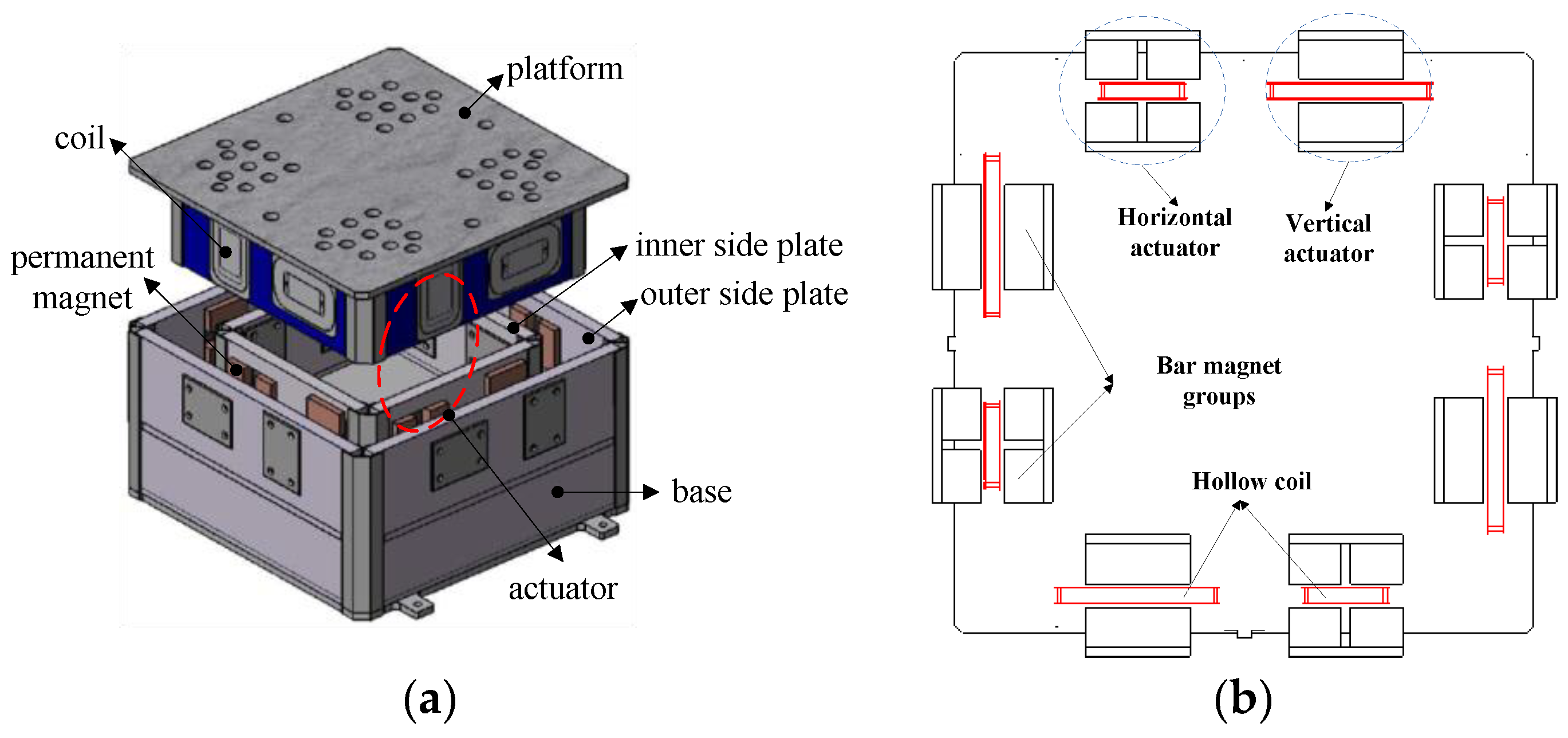
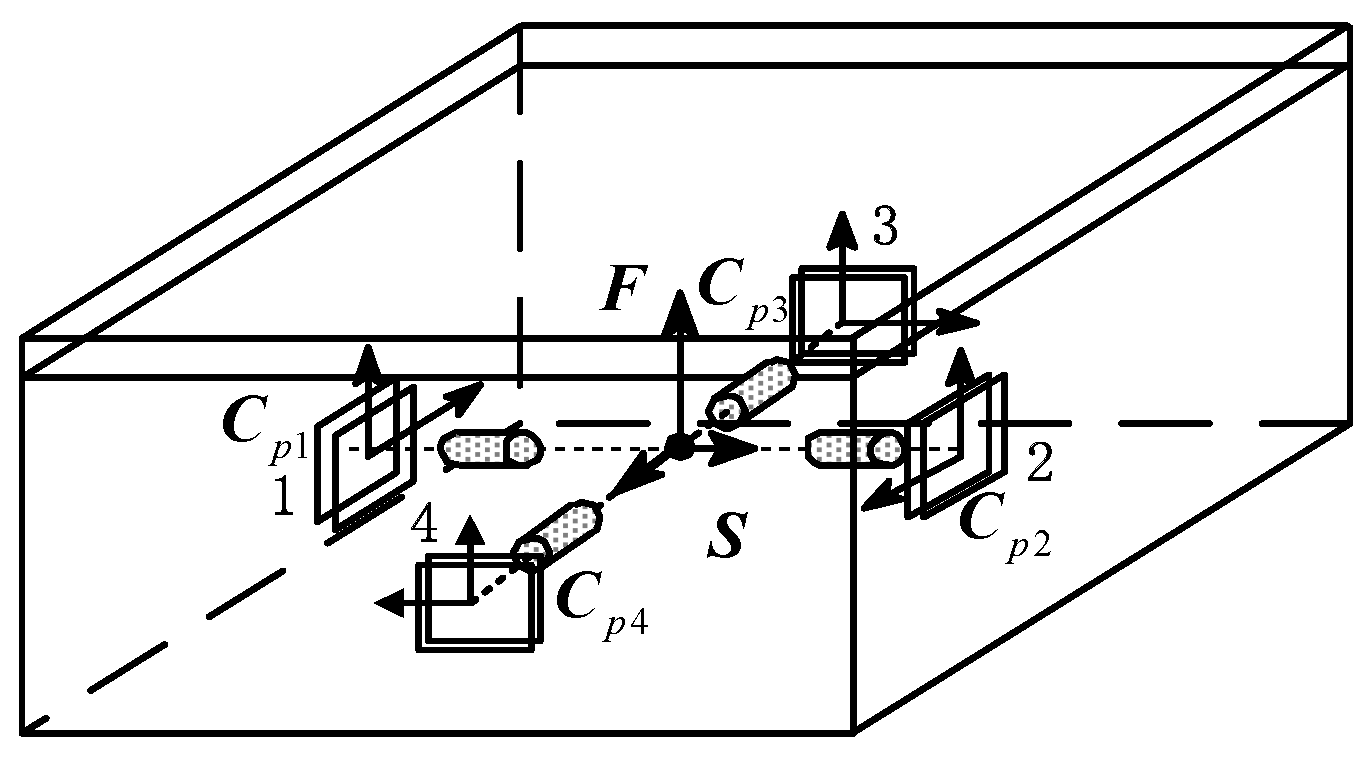
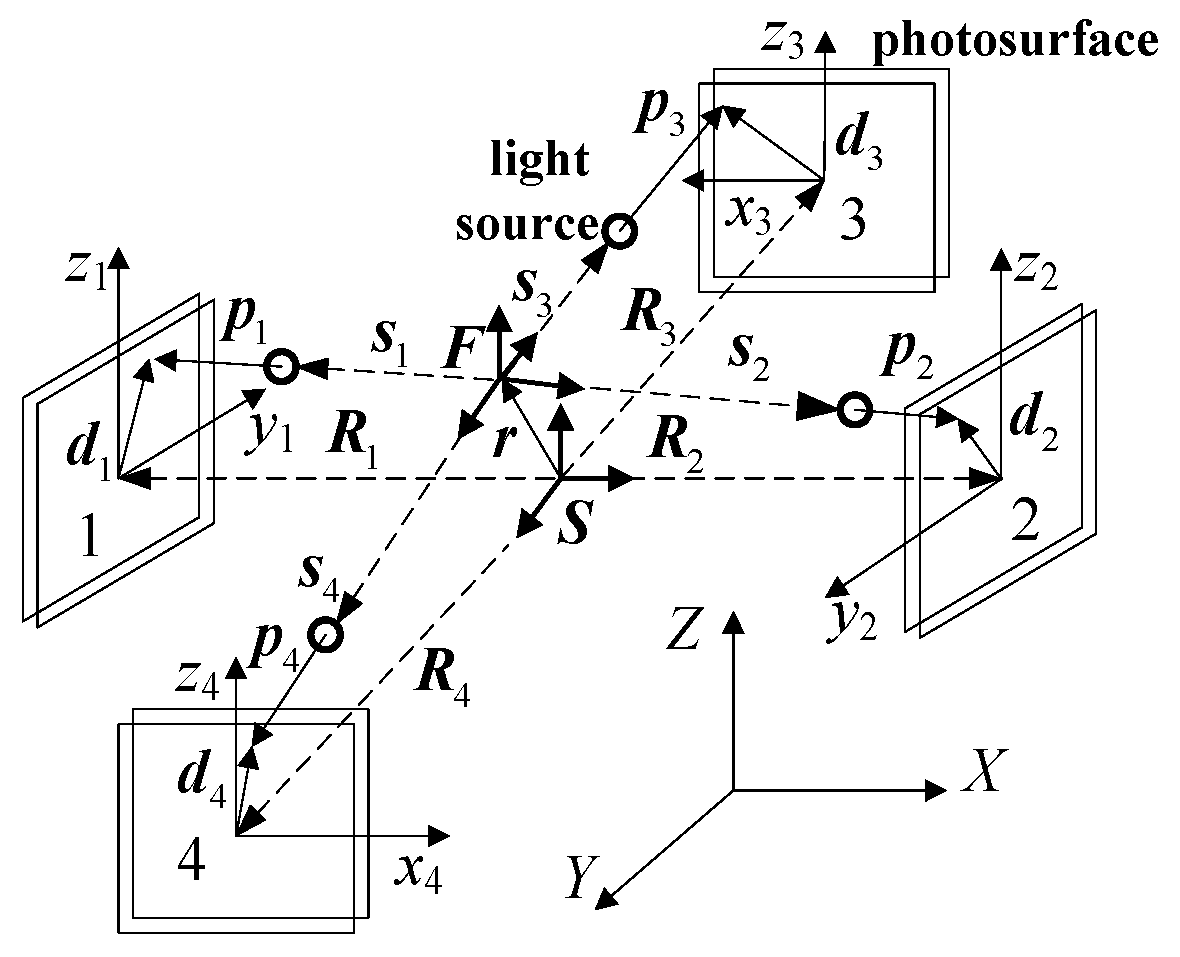




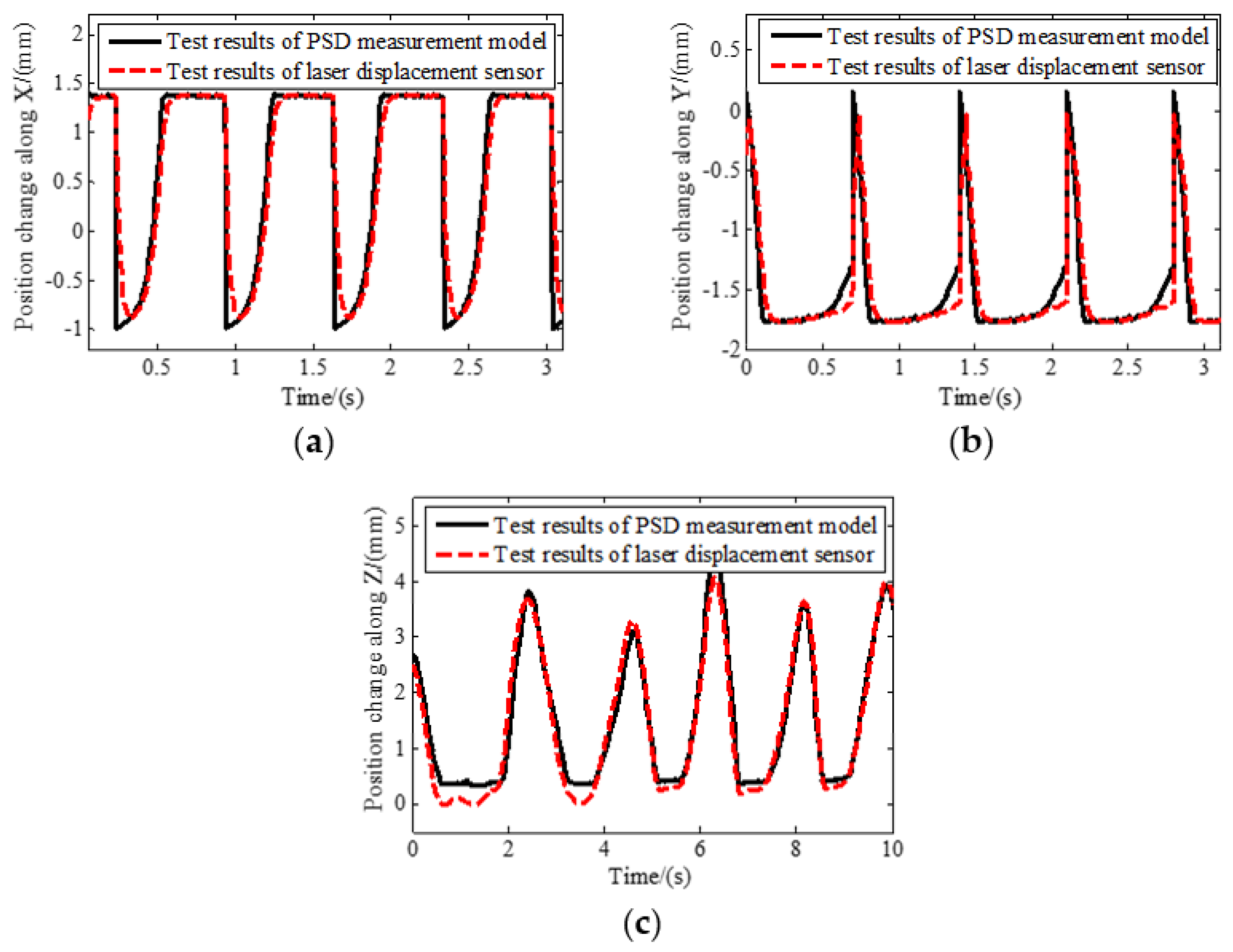
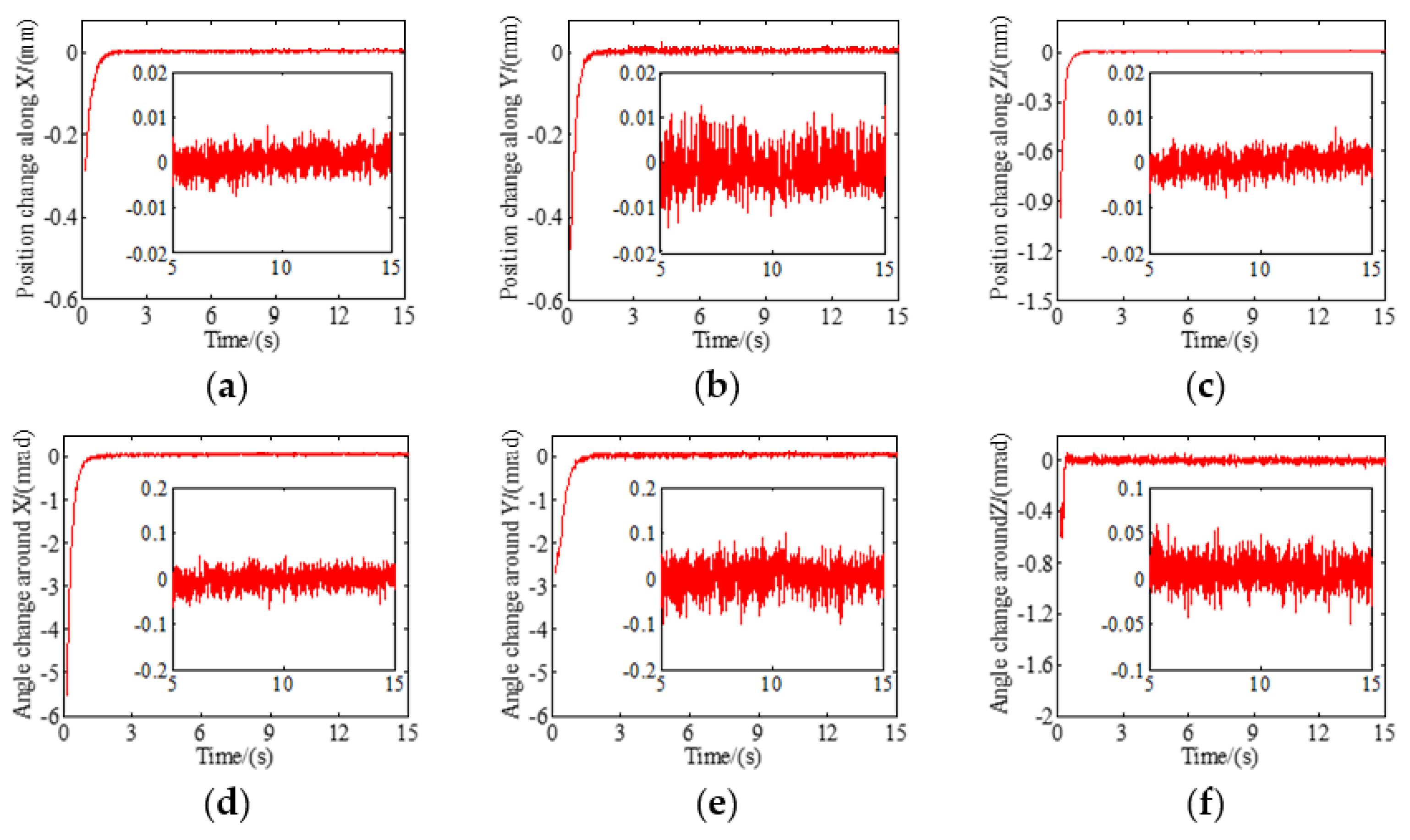
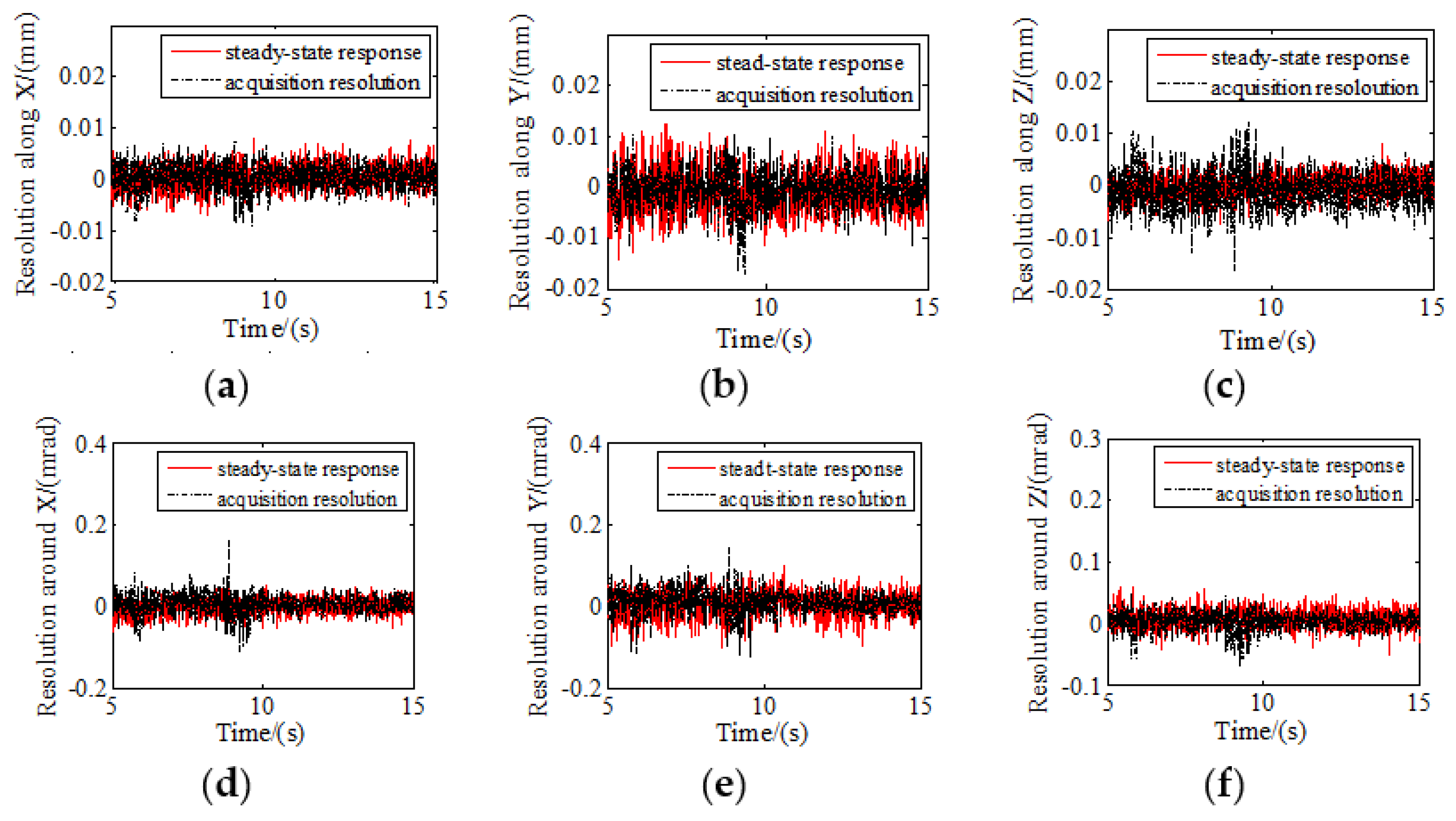
| Description | Value |
|---|---|
| m/Kg | 5.42 |
| Jxx/Kg·m2 | 0.1005 |
| Jxy/Kg·m2 | −4.776 × 10−6 |
| Jxz/Kg·m2 | 0 |
| Jyy/Kg·m2 | 0.1005 |
| Jyz/Kg·m2 | 0 |
| Jzz/Kg·m2 | 0.195 |
| Description | Value (N/A) |
|---|---|
| Actuator 1 | 8.0911 |
| Actuator 2 | 8.0911 |
| Actuator 3 | 8.2748 |
| Actuator 4 | 8.2748 |
| Actuator 5 | 8.0911 |
| Actuator 6 | 8.0911 |
| Actuator 7 | 7.9093 |
| Actuator 8 | 7.9093 |
| Description | Stiffness Matrix (N/mm) | Damping Matrix (N·s/mm) |
|---|---|---|
| Power cable | [−22.16 0 45.73;0 7.44 0; −45.25 0 61.85] | [0.0013 0 −0.0011;0 −0.0106 0;0.0102 0 0.0305] |
| Signal cable | [−30.24 0 62.35;0 8.78 0; −62.67 0 91.62] | [−0.025 0 0.0016;0 −0.0023 0; −0.012 0 −0.0253] |
| Along X/mm | Along Y/mm | Along Z/mm |
|---|---|---|
| 0.109 | 0.129 | 0.585 |
| Along X | Along Y | Along Z | Around X | Around Y | Around Z |
|---|---|---|---|---|---|
| 0.0078 | 0.0108 | 0.0187 | 1.03 × 10−4 | 7.87 × 10−5 | 2.47 × 10−5 |
© 2019 by the authors. Licensee MDPI, Basel, Switzerland. This article is an open access article distributed under the terms and conditions of the Creative Commons Attribution (CC BY) license (http://creativecommons.org/licenses/by/4.0/).
Share and Cite
Wu, Q.; Liu, B.; Cui, N.; Zhao, S. Tracking Control of a Maglev Vibration Isolation System Based on a High-Precision Relative Position and Attitude Model. Sensors 2019, 19, 3375. https://doi.org/10.3390/s19153375
Wu Q, Liu B, Cui N, Zhao S. Tracking Control of a Maglev Vibration Isolation System Based on a High-Precision Relative Position and Attitude Model. Sensors. 2019; 19(15):3375. https://doi.org/10.3390/s19153375
Chicago/Turabian StyleWu, Qianqian, Bilong Liu, Ning Cui, and Sifang Zhao. 2019. "Tracking Control of a Maglev Vibration Isolation System Based on a High-Precision Relative Position and Attitude Model" Sensors 19, no. 15: 3375. https://doi.org/10.3390/s19153375




